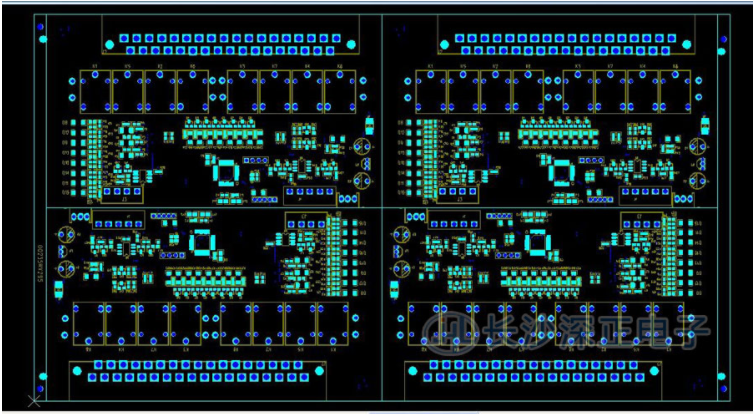Printed circuit board (PCB) wastewater has a large amount of water, many types of wastewater pollutants, complex components, containing multiple complexing agents (chelating agents) such as ammonia, EDTA, tartrate, etc., forming stable complexes with heavy metal ions such as copper, Which seriously affects the treatment of heavy metals such as copper, and is difficult to handle. As far as PCB complex wastewater treatment is concerned, the removal of complexes has become the key to the removal of heavy metals such as copper.
1. The principle of using iron-carbon micro-electrolysis method to treat PCB complexing wastewater: complexed heavy metal wastewater undergoes micro-electrolysis and displacement reactions in the micro-electrolysis reactor:
Anode (Fe): Fe- 2e- Fe2
Cathode (C): 2H 2e- 2[H]-H2
On the one hand, the micro-electrolysis reaction produces new ecological hydrogen and ferrous iron, which can undergo redox reactions with many substances in the water, destroy the structure of the complex, and make it lose or reduce the ability to complex with copper and other heavy metals, and at the same time, the new Fe(OH)2 and Fe(OH)3 have high flocculation and adsorption activity, which can absorb dispersed small particles and organic molecules in water to flocculate and settle down, so as to further purify wastewater. On the other hand, iron can undergo a substitution reaction with copper in the wastewater, and iron replaces the copper in the complexed copper into elemental copper.
2. Typical technological process

The iron-carbon micro-electrolysis method has the advantages of wide application range, good treatment effect, long application life, low cost, convenient operation, etc., and has been widely used in PCB complex wastewater treatment.
Three, the eight advantages of TPFC filler in the treatment of complex wastewater
Compared with traditional iron-carbon micro-electrolytic fillers, TPFC has the following advantages:
1. Designed specifically for environmental protection
Different from the steelmaking pellet modified products on the market, TPFC filler is specially designed for environmental protection, and the production process and formula are adjusted according to different water quality to achieve the best response effect.
2. Developed micropores, large specific surface area and high activity
TPFC uses high-temperature magnetization structure, microporous activation technology, and high ZeTa potential on the surface. Compared with the steel-making pellet modified product (oblate) on the market, the electron pair formed per unit Fe-C is one order of magnitude higher, and the reaction rate is The purification efficiency is high, which can greatly reduce the pollutant ring opening, chain scission and the activation energy of the reaction.
3. The contact reaction of the regular spherical structure is more thorough and it is easy to backwash
TPFC adopts a regular spherical structure, filling the gaps more uniformly, the waste water is in contact with the particle surface more fully, the mass transfer efficiency is higher, and the reaction is more thorough. All filter bed structured packings need to be backwashed regularly during the filtration process, while the spherical structure of TPFC has low density, easier backwashing, and more convenient use and management.
4. Iron-carbon-M is evenly distributed, and the electrochemical reaction efficiency is higher
TPFC production and processing uses 200 mesh raw materials mixed into balls, iron-carbon-M elements are uniformly mixed, the number of positive and negative electrode pairs is larger, the electron transfer resistance during the discharge reaction is smaller, the reaction is more efficient, and the decontamination, detoxification, and degradation capabilities are stronger, The purification efficiency is higher.
The number of carbon flakes in the steel-making pellets (oblate) iron-carbon on the market is small, the distribution is uneven, and the reaction efficiency is naturally low. After the oblate structure is stacked and filled, the space is uneven, and the mass transfer efficiency of the waste water and the filler is low, which affects the overall treatment effect.
5. No passivation
TPFC organically combines the positive and negative electrode materials and catalytic elements of the micro-electrolysis, that is, countless positive and negative electrode pairs are formed in a single particle at the same time, so that the discharge reaction is always unimpeded, and fundamentally avoids the dense oxidation of the surface of the material due to the micro-electrolysis process. Passivation caused by material covering occurs. Really achieve no passivation, no need to replace, just add it regularly according to its slow dissolution rate.
6. No blockage
TPFC is a single material (multi-element composite), no need to be assembled, the density is consistent, and it can be backwashed regularly, which fundamentally solves the problems of impurity blockage between materials and packing compaction during use.
7. Small consumption and low operating cost
TPFC discharge reaction efficiency is high, the consumption of micro-electrolysis material per unit COD removal is small, the amount of sludge generated is small, and the treatment cost is low.
8. Stable pretreatment (detoxification) effect ensures efficient subsequent biochemical operation
Pretreatment processes such as dosing and advanced oxidation often lag behind the control of reaction conditions when the incoming water quality fluctuates, which cannot fully guarantee the effluent quality, and is likely to have a destructive effect on the subsequent biochemical treatment (this is also the past high-concentration toxic industrial wastewater biochemical system is difficult to stabilize and efficient Root cause of operation). The TPFC adopts a filtering method, and the fluctuation of incoming water quality has little effect on the effluent quality, which can fully ensure that the biodegradability of the effluent water quality meets the subsequent biochemical treatment requirements, maintain the stable and efficient operation of the biochemical treatment unit, and finally ensure that the effluent quality meets the standard.